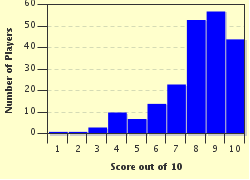Quiz Answer Key and Fun Facts
1. One of the most famous walls in British history was built in the North of England, close to the modern Scottish border, by the Roman Emperor Hadrian. At over 100km long, what is considered to have been its primary goal?
2. During World War II Nazi Germany was concerned that the Allies, with their advanced and vast naval forces, might launch an attack on mainland Europe. Their answer was to build defenses around the Western coast of mainland Europe, from Norway down to the South of France. It was never quite finished but parts of it remain today. What was this wall called?
3. Which Israeli site, also known as the Western Wall, is a site of pilgrimmage for Jewish people and is said to be the last remains of the Holy Temple of King Solomon?
4. The Peace Lines are a series of barriers and walls built in Belfast, Northern Ireland from the 1960s to separate which two groups during The Troubles?
5. In 1961 the Berlin Wall was erected in a desperate attempt to prevent East Germans from continuing to escape to the West. Though it started life as a wire fence with military guards, by 1962 most sections had been rebuilt with reinforced concrete. In which year did the wall finally begin to be torn down following demonstrations by East Germans?
6. Sacsayhuamán is a walled fortress on a steep hill overlooking the Peruvian city of Cuzco. The interlocking stones helped these walls survived earthquakes for hundreds of years. Which civilisation built these polished stone walls in around the fifteenth century?
7. In 1982, a long, black wall bearing hundreds of names was designed by artists Maya Lin and erected in Constitution Gardens, Washington D.C. It was designed as a memorial for US veterans of which war, also known as the "American War"?
8. The fired-clay walls around a famous ancient city state in the area that is now modern-day Iraq were once considered a wonder of the ancient world due to their length and size. They were built by a number of rulers, though Nebuchadnezzar II increased their size significantly around 600 BC. Which city did they stand around?
9. Great Zimbabwe is a ruined walled city in the country now known as Zimbabwe. The ruined city is named after the ruins themselves, which are known as "zimbabwes", with the "Great" having been added in tribute to the 11 metre high walled Great Enclosure where most inhabitants would have lived. What indigenous people built the city's walls?
10. The Great Wall of China is probably the most famous wall on the planet. It stretches for almost 9,000km across Northern China and large sections are still well-preserved. Although the most famous part of the wall is that built by the first Emperor of China around 200 BC, most the wall was built by which dynasty between around 1368 and 1644?
Source: Author
suzidunc
This quiz was reviewed by FunTrivia editor
bloomsby before going online.
Any errors found in FunTrivia content are routinely corrected through our feedback system.

